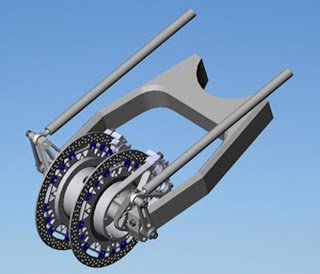




Hub-center steering (HCS) is one of several different types of front end suspension/steering mechanisms used in motorcycles. Hub-center steering is characterized by a swingarm that extends from the bottom of the engine/frame to the centre of the front wheel instead of two forks. The advantages of using a hub-center steering system instead of a more conventional motorcycle fork are that hub-center steering separates the steering, braking, and suspension functions. With a fork the braking forces are put through the suspension, a situation that leads to the suspension being compressed, using up a large amount of suspension travel which makes dealing with bumps and other road irregularities extremely difficult.
As the forks dive the steering geometry of the bike also changes making the bike more nervous, and inversely on acceleration becomes lazier. Also, having the steering working through the forks causes problems with stiction, decreasing the effectiveness of the suspension. The length of the typical motorcycle fork means that they act as large levers about the headstock requiring the forks, the headstock, and the frame to be very robust adding to the bike's weight.Hub-center steering systems use an arm, or arms, on bearings to allow upward wheel deflection, meaning that there is no stiction, even under braking.
Braking forces can be redirected horizontally along these arms (or tie rods) away from the vertical suspension forces, and can even be put to good use to counteract weight shift. Finally, the hub center steering's achilles heel, however, has been steering feel. Complex linkages tend to be involved in the steering process, and this can lead to slack, vague, or inconsistent handlebar movement across its range.

No comments:
Post a Comment